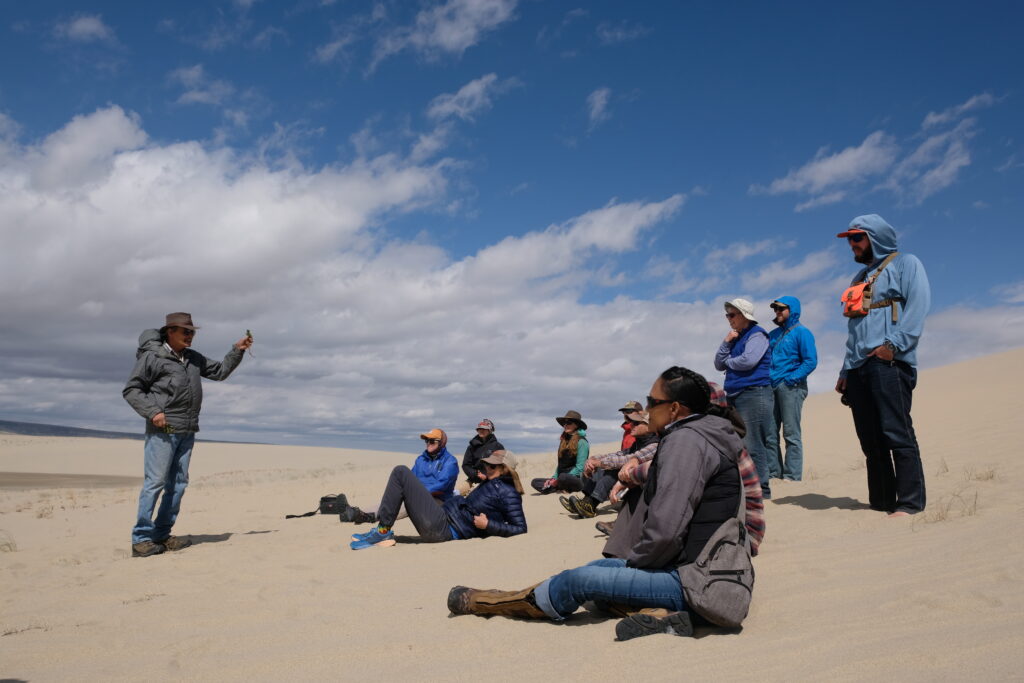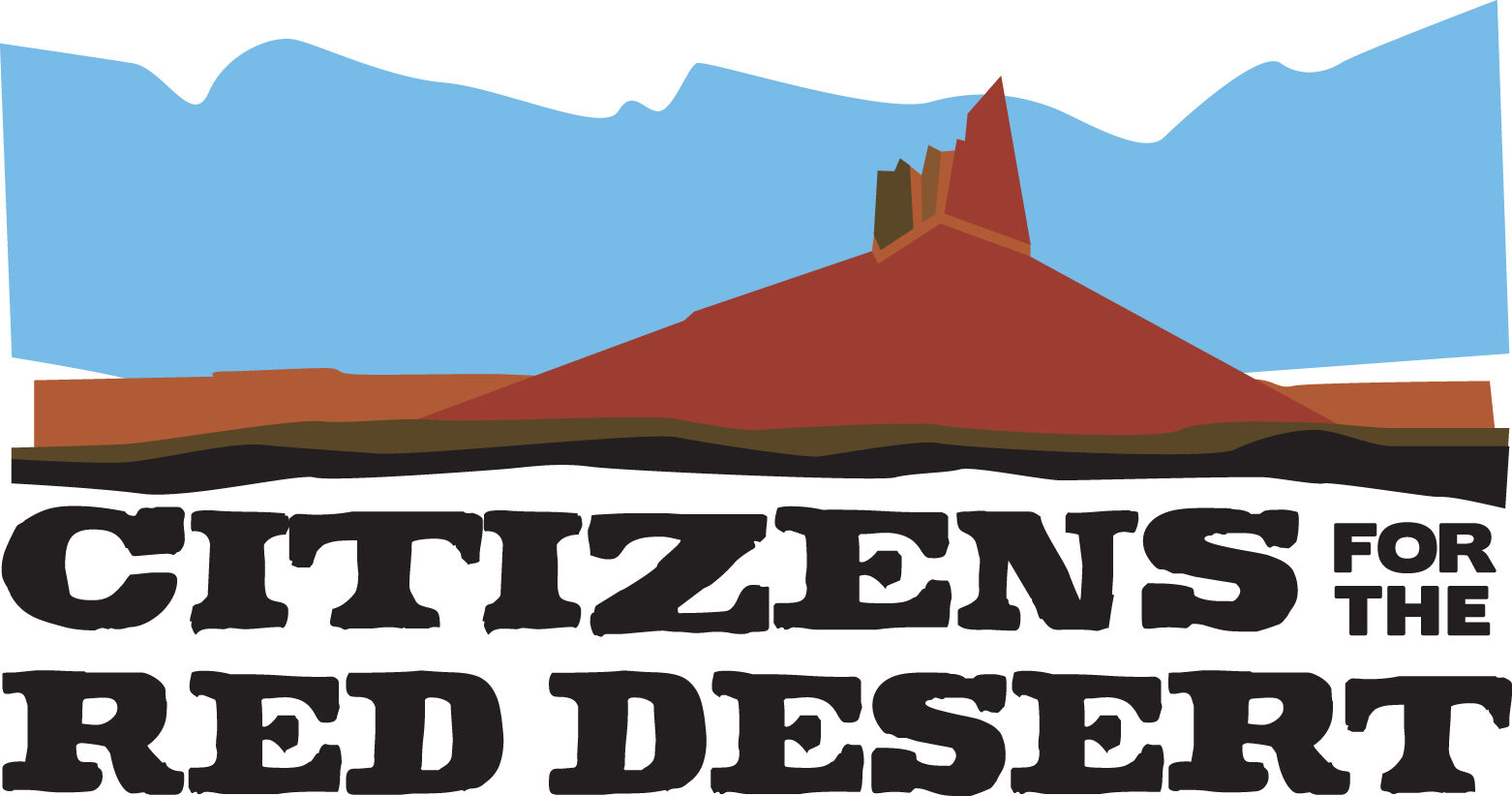
The findings section is an introduction to legislation and outlines our shared values that we want protected with congressional legislation.
Introduction to the Red Desert
Whereas – the Red Desert of Wyoming is a vast, high elevation desert that is rich with the history, scenic beauty and wildlife of the American West. It is a wild and remote landscape at the crossroads of our continent, whose story has defined our nation. The Desert has been home to Indigenous people since time immemorial and served as a gateway for the nation’s continental expansion. It is a land with colorful buttes and badlands, iconic landmarks, and diverse habitats that support large herds of big game and unique species. It contains the largest living sand dunes complex in North American and is reportedly the largest unfenced area in the Lower-48. It is a working, nourishing landscape that has supported human use and travel for generations.
Indigenous Values
Whereas – the Red Desert is an Indigenous ancestral landscape. The Shoshone, Ute, Goshute, Paiute, Bannock, Arapaho, Cheyenne, Lakota, and Crow have lived, hunted, and prospered in these vast lands for generations. The Shoshone and Ute whose heritage ascends from the Red Desert were among the first to develop horse-based commerce across the West. In 1863 the Ft. Bridger Treaty established the 44-million-acre Shoshone Reservation, encompassing the Red Desert. Five years later the Reservation was reduced to 3.1 million acres. The Eastern Shoshone, along with the Northern Arapaho, now reside on the Wind River Indian Reservation, bordering the Red Desert to the north.
Whereas – the Red Desert is an Indigenous living cultural corridor. For over 10,000 years, Indigenous peoples have been hunting, gathering, and traveling the Red Desert. A network of trails, buffalo jumps, teepee rings, and numerous petroglyphs and dwellings endure as spiritual places for traditional and contemporary uses by Native people. Indian Gap Trail is an ancient trade network that follows animal migrations, and the Boars Tusk is a respected, spiritual landmark. The Red Desert also provides year round plant gathering for food and medicine to Indigenous peoples. All the Tribes continue to share oral histories that connect their people and language to this homeland.
Western Expansion History/Values
Whereas – the Red Desert is the geographic heart of the American story of manifest destiny. It marks the confluence of three western territories – where Mexico, Britain and the new United States clashed for dominance of the North American continent. This convergence is marked at the Tri Territorial Site. South Pass, the easiest route across the Rocky Mountains and Continental Divide, was used by generations of Tribal Nations and then by early explorers, mountain men and western bound emigrants. It was the geographic key that unlocked the nation’s expansion and allowed the U.S. to grow into a dual-coastal nation of global power. As a critical travel and communication link, South Pass was also instrumental for ensuring California and its gold supported the Union during the Civil War.
Whereas – the Red Desert contains some of the least disturbed segments of our National Historic Trails, including the Oregon, California, Mormon Pioneer and Pony Express Trails. Thanks to the vast sagebrush spaces that remain, the terrain on these trails appears as it did 170 years ago. Marked historical sites are located along these trails including graves, South Pass National Historic Landmark, Mormon handcart sites and several Pony Express stations.
Whereas – the Red Desert is a showcase of frontier history. As a major thoroughfare for wagon trains, gold seekers, Mormon handcart emigrants, stagecoach passengers, freighters, outlaws, army garrisons, Pony Express riders, and others, this past is evidenced by the restored gold-mining ghost towns of South Pass City and Miners Delight, and the living community of Atlantic City. Many stage and freight roads, abandoned ranches and way stations can be reached along these historic routes.
Wildlife/Habitat
Whereas – the Red Desert, which includes the Golden Triangle, helps sustain some of North America’s largest and longest distance migratory herds of wild ungulates. Most notably this includes the Red Desert to Hoback mule deer migration – longest documented in the world; crucial winter range and migratory routes for the state’s largest pronghorn herd; and over 1,000 desert-dwelling elk. The habitats for these species overlap with each other creating what has been called the “Serengeti of the American West”.
Whereas – the Red Desert contains one of the largest remaining expanses of unfragmented sagebrush in the United States, resulting in the highest density of Greater Sage-Grouse in the world.
Whereas – the Red Desert is a land of diverse habitats, including sagebrush steppe laced with springs and aspen stands; unique ephemeral ponds within the Sand Dunes; desert badlands and volcanic buttes. This diversity provides important habitat for many species of resident mammals as well as nesting and migrating birds, including two designated Tier 1 Species of Greatest Conservation Need in Wyoming, Burrowing Owl and Mountain Plover.
Economic Activity
Whereas – the Red Desert is a working landscape, with generational family ranches, outfitting, prospecting and oil and gas development – which are part of the heritage of Wyoming. Responsible stewardship and targeted restoration can ensure these activities continue to be balanced for protecting the Red Desert’s wild nature, and cultural and natural resources.
Whereas – The Red Desert landscape can promote robust economic growth, through emerging tourism such as big-game hunting, bird-watching, motorized and non-motorized recreation, professional outfitting and guiding operations, and other outdoor-enthusiast visitations. All of which will generate sustainable revenue for local communities.
Access, Hunting, Outdoor Rec
Whereas – the Red Desert is an accessible landscape. A network of dirt roads provide access through the remote and rugged landscape for a variety of multiple uses, including ranching, recreation, cultural uses, education, and opportunity for spiritual experience, solitude, and reflection.
Whereas – the Red Desert provides world-class big game hunting opportunities, including coveted trophy mule deer, iconic pronghorn, and rare desert elk tags, helping to fuel Wyoming’s economy.
Whereas – the Red Desert offers unique opportunities for remote and backcountry outdoor recreation. For generations this landscape has supported traditional recreational uses such as hunting, horse riding, camping, wildlife viewing, hiking, rock hounding, and supports contemporary uses such as cycling, ORV use, backpacking, and RV touring.
Whereas — the Red Desert holds promise for local economic diversification through responsible well-managed recreational use. The landscape draws visitors from across the country, improving the quality of life for the gateway communities of Rock Springs, South Pass and Atlantic City, Pinedale, Farson, Lander, and Jeffery City.
Spiritual
Whereas – the Red Desert is a timeless space of spiritual significance where the majesty of creation is revealed in the canyon walls, vast dunes, the strata of the mountains, the energy of the cosmos, in the power of the wind, and the silence of the stars. The Red Desert offers serenity to the soul and spiritual solace in the modern world.
Whereas – the Red Desert opens our sensitivity to the unity of creation. The fragile interplay of species awakens visitors to the web of Life. In the solitude of the desert one can experience a deeper sense of connection to all that is.
Wildness
Whereas – the Red Desert contains the largest concentration of wild and roadless areas on BLM lands in Wyoming. These areas protect Indigenous cultural resources, world-class night skies, iconic and wide-open vistas, and unique geology, all while being some of the least statutorily protected regions in Wyoming. Undeveloped wild landscapes serve as natural benchmarks for monitoring ecological change, harbor rare plants, and provide seasonally important habitats to a broad range of wildlife. The Red Desert’s ancient and pristine character provides a place undisturbed where people may experience solitude and a space for reflection that is rapidly disappearing from the American West.
The Need for Legislation
Whereas – the Red Desert is a landscape of many uses, with potential for responsible economic opportunity balanced with conservation. Wise stewardship and certainty are necessary to ensure its wild Western legacy is sustained for future generations.
Education
Whereas – The Red Desert contains nationally significant cultural, historic, and natural resources which are a source of inspiration and learning for all Americans. These resources, when stewarded, provide benefits for tourism, school programs, cultural awareness and cutting- edge science through sharing untold stories, multiple perspectives, and connecting the past with society’s evolving challenges.
